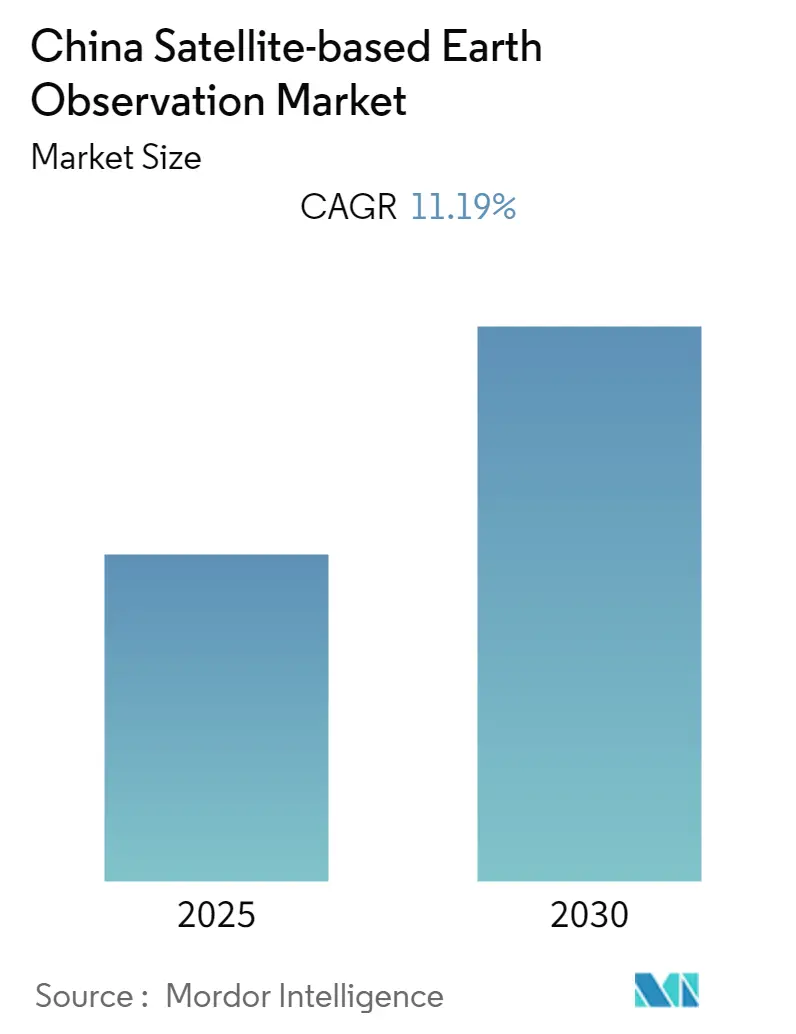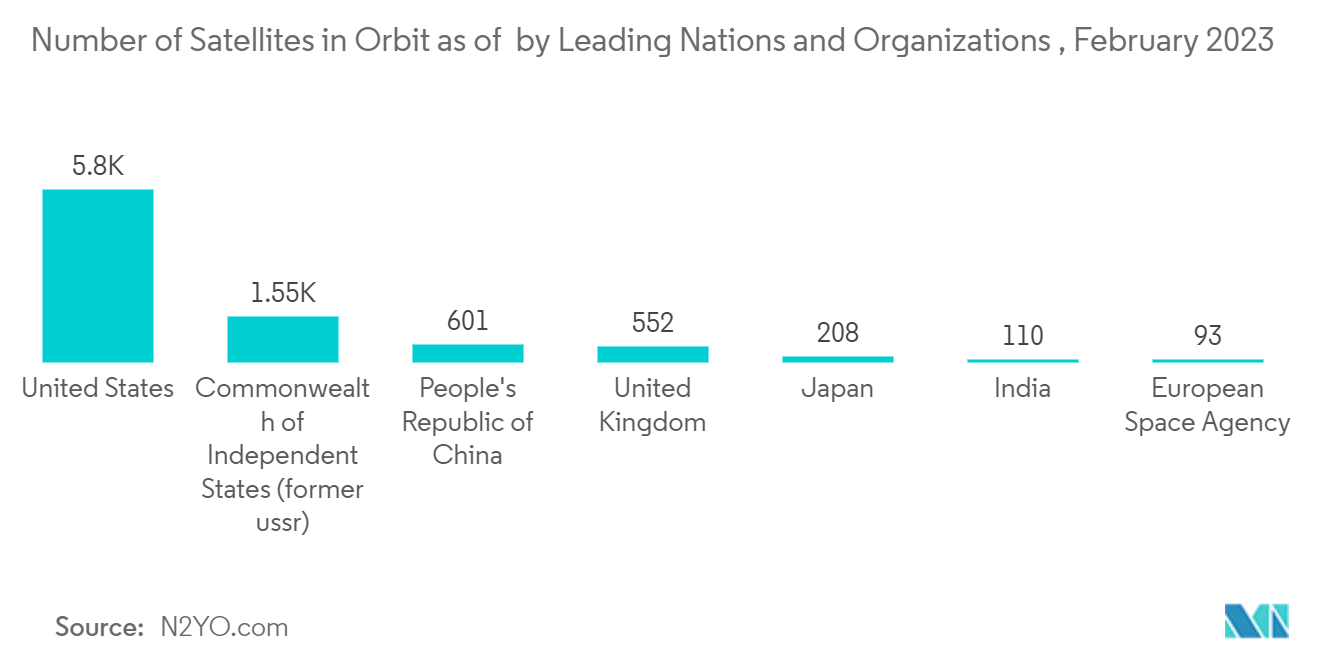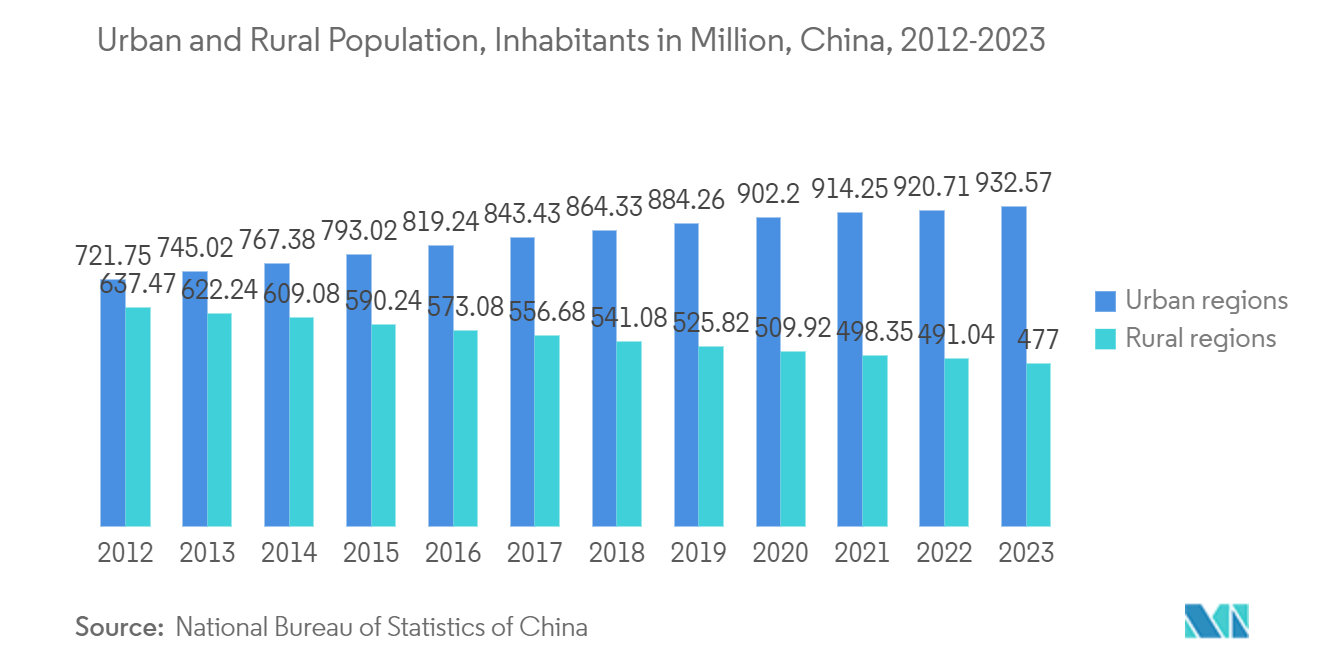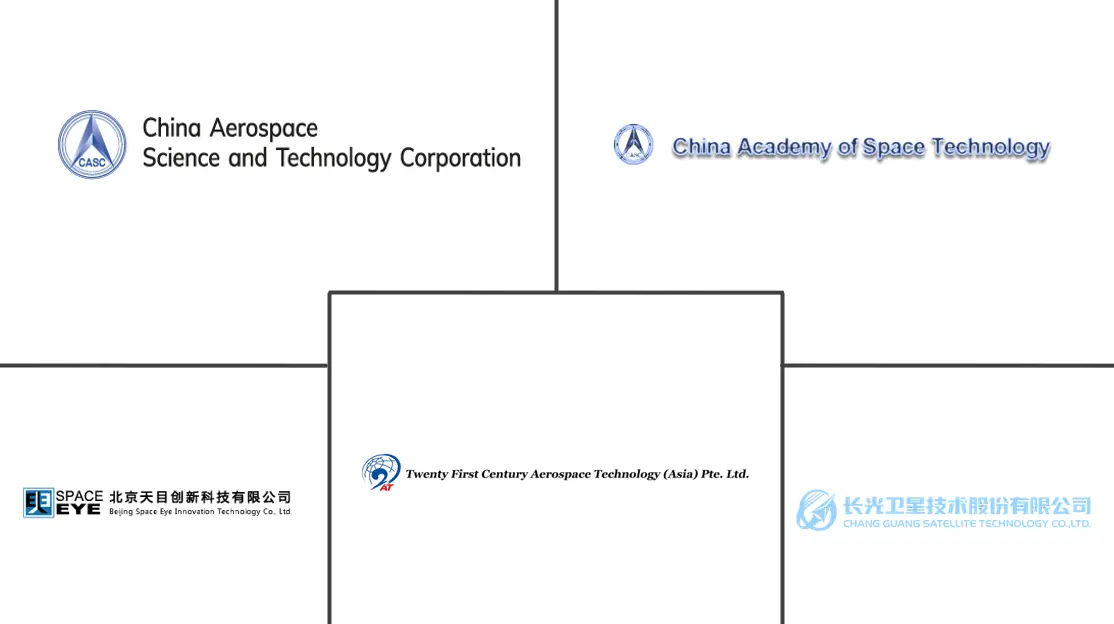China Satellite-based Earth Observation Market Size and Share

China Satellite-based Earth Observation Market Analysis by Mordor Intelligence
The China Satellite-based Earth Observation Market is expected to register a CAGR of 11.19% during the forecast period.
China has made substantial progress in satellite technology, including high-resolution imaging, hyperspectral imaging, and synthetic aperture radar (SAR) systems. Technological advancements have improved data accuracy, resolution, and the ability to collect real-time data, thus driving the demand for satellite-based EO services.
- The China Satellite-based Earth Observation (EO) Market has recently grown and developed significantly. China has emerged as a key player in the global EO market with a strong emphasis on space exploration and a robust satellite industry. Satellite-based EO technology provides crucial data and insights for various applications, ranging from environmental monitoring and resource management to disaster response and urban planning.
- The Chinese government has strongly committed to advancing its satellite-based EO capabilities. It has launched several satellite programs, such as the Gaofen series, Ziyuan series, and Fengyun series, with a focus on high-resolution imaging, hyperspectral imaging, and SAR technology. These initiatives aim to enhance national security, environmental protection, disaster management, and resource monitoring.
- Moreover, China's commercial sector recognizes the value of satellite-based EO data for diverse applications. Precision agriculture, urban planning, insurance, and infrastructure development increasingly utilize EO services. The growing interest from commercial entities drives market expansion and stimulates private investment in the sector.
- Additionally, the Chinese government has implemented policies and regulations to support the growth of the EO market. These include data sharing guidelines, satellite data commercialization, and licensing procedures. Clear rules create a conducive environment for private enterprises, fostering innovation and investment in the sector.
- Moreover, international collaboration and data exchange are vital in the EO market. However, geopolitical factors, data security concerns, and political restrictions can hinder international cooperation. Limited international collaboration can restrict access to global datasets, technological advancements, and market expansion opportunities.
China Satellite-based Earth Observation Market Trends and Insights
Rising Investments and Government Initiatives to Drive the Market Growth
- Rising investments and government initiatives play a crucial role in driving the growth of the China Satellite-based Earth Observation (EO) Market. These factors contribute to the market's expansion by fueling technological advancements, encouraging innovation, and creating a favorable environment for market players.
- The market has witnessed a surge in investments in recent years. Both domestic and international investors recognize the market's potential and the value of satellite-based EO services. Investments are directed toward various areas, including satellite manufacturing, data processing and analytics, infrastructure development, and commercial applications. The influx of capital stimulates innovation, fuels research and development activities, and accelerates market growth.
- This substantial investment demonstrates the country's commitment to the space sector, including satellite-based EO. The availability of such significant funding enables the development of advanced satellite technologies, data processing capabilities, and commercial applications. These investments contribute to the growth of the China Satellite-based EO Market by providing the necessary financial resources for research, innovation, and market expansion.
- The combination of rising investments and government initiatives fosters a competitive landscape in the China Satellite-based EO Market. Market players strive for innovation and differentiation to gain a competitive edge. Increased investments facilitate collaboration and partnerships between industry players, research institutions, and government entities. Collaborative efforts promote knowledge sharing, technology transfer, and joint research projects, leading to enhanced capabilities and the development of new services. The resulting market competitiveness drives continuous improvement, innovation, and market expansion.
- In addition, rising investments and government initiatives contribute to the expansion and commercialization of the China Satellite-based EO Market. Companies can leverage the available resources to develop and launch new EO satellites, establish data processing and analytics centers, and build a robust ecosystem of EO service providers. The commercialization of EO services enables companies to offer value-added solutions to customers across sectors such as agriculture, forestry, urban planning, disaster management, and environmental monitoring. Market expansion and commercialization efforts create revenue generation, job creation, and economic growth opportunities.
- Overall, rising investments and government initiatives are instrumental in driving the growth of the China Satellite-based EO Market. The combination of financial resources, supportive policies, and collaborative efforts enables technological advancements, market competitiveness, and commercialization of EO services. As a result, the market experiences expansion, innovation, and the ability to address various societal and environmental challenges.

Urban Development and Cultural Heritage to Hold a Significant Market Share
- China has been experiencing rapid urbanization, with a significant portion of its population migrating from rural to urban areas. This urbanization process has created a demand for effective urban planning, infrastructure development, and management of urban environments. Satellite-based EO provides valuable data and insights for urban development projects, such as land-use planning, transportation networks, and environmental monitoring. The ability to monitor and analyze urban areas from space facilitates efficient urban development and plays a crucial role in shaping sustainable and resilient cities.
- Moreover, China has undergone a significant transformation in terms of urbanization over the past few decades. According to the World Bank, in 1980, only 19.4% of the Chinese population resided in urban areas. However, this has changed dramatically over time. As of 2022, approximately 65.2% of Chinese people live in urban regions, showcasing a remarkable shift. The country is now home to a staggering 491 million rural residents and 921 million urban residents. China's population reached around 1.41 billion in 2022, making it the most populous country in the world. This rapid urbanization has created a significant demand for effective urban planning, infrastructure development, and the management of urban environments.
- Satellite-based EO is vital in infrastructure planning and monitoring, including constructing and maintaining transportation networks, buildings, and utilities. The data captured by satellites can be utilized for mapping urban infrastructure, monitoring construction progress, assessing the condition of roads and bridges, and identifying potential risks or maintenance requirements. This information helps optimize infrastructure planning, reduce costs, and ensure the safety and longevity of urban structures.
- In addition, China boasts a rich cultural heritage with numerous historical sites, monuments, and heritage areas. Preserving and safeguarding this cultural heritage is of paramount importance. Satellite-based EO enables the documentation, monitoring, and conservation of cultural heritage sites. High-resolution satellite imagery, combined with advanced image analysis techniques, can detect changes, monitor degradation, and assist in preserving and managing cultural heritage assets. Satellite data provides valuable insights for archaeological studies, site documentation, and identifying potential threats to cultural heritage sites.
- Overall, urban development and cultural heritage hold a significant market share in the China Satellite-based EO Market due to rapid urbanization, infrastructure planning and monitoring, cultural heritage preservation, environmental management requirements, and government initiatives. Integrating satellite-based EO data in urban development and cultural heritage management processes enhances decision-making, improves sustainability practices, and contributes to the overall development and preservation of urban areas in China.

Competitive Landscape
The China Satellite-based Earth Observation Market is expected to be moderately consolidated. Specific segments of the China Satellite-based EO Market exhibit consolidation, such as satellite manufacturing and launch, while other areas like data processing and analytics, EO services, and applications are more fragmented. Large and small players in the market signify a combination of consolidation and fragmentation, indicating a dynamic and diverse ecosystem. China Aerospace Science and Technology Corporation, China Academy of Space Technology (CAST), Beijing Space Eye Innovation Technology Co., Ltd., Chang Guang Satellite Technology Co., Ltd, Twenty First Century Aerospace Technology (Asia) Pte. Ltd., etc., are few prominent players operating in the market.
In March 2023, an optical geostationary Gaofen-13 (02) satellite was launched by China, expanding its initial civilian Gaofen Earth monitoring series. A Long March 3B rocket was launched from the hill-surrounded Xichang Satellite Launch Centre. According to the China Aerospace Science and Technology Corp. (CASC), the launch successfully placed the Gaofen-13 (02) satellite into a geosynchronous transfer orbit.
In December 2022, Gaofen 11-04, an Earth observation satellite, was launched by China, according to China Aerospace Science and Technology Corp. The state-owned space contractor's Taiyuan Satellite Launch Centre in Shanxi province launched the Long March 4B carrier rocket that carried the satellite into orbit. The satellite was created by the China Academy of Space Technology, a Beijing-based CASC affiliate, and is tasked with supplying photos and data for land mapping and management, urban development planning, agricultural output predictions, and disaster prevention and relief.
China Satellite-based Earth Observation Industry Leaders
-
China Aerospace Science and Technology Corporation
-
China Academy of Space Technology (CAST)
-
Beijing Space Eye Innovation Technology Co., Ltd.
-
Chang Guang Satellite Technology Co., Ltd
-
Twenty First Century Aerospace Technology (Asia) Pte. Ltd.
- *Disclaimer: Major Players sorted in no particular order

Recent Industry Developments
- May 2023: China launched two satellites to refuel its Beidou navigation system and place test satellites for science and radar technology in space. The Jiuquan Satellite Launch Centre in the Gobi Desert launched a Long March 2C rocket. The Luojia-2 (01), a Ka-band synthetic aperture radar (SAR) test satellite for Wuhan University, and the Macau Science Satellite 1A and 1B, both of which are intended to study the Earth's magnetic field, were both on board.
- April 2023: Chinese researchers claimed to have carried out a "landmark experiment" by giving an artificial intelligence (AI) system temporary control of a satellite in close-to-Earth orbit to evaluate its behavior as it would behave in space. According to a report published in the journal Geomatics and Information Science of Wuhan University, Qimingxing 1, a tiny Earth observation satellite, was managed by the AI for 24 hours and operated without human instruction, assignment, or intervention.
China Satellite-based Earth Observation Market Report Scope
Satellite-based earth observation is done with the help of satellites orbiting around the planet to view and identify environmental changes, map making, etc. The satellite-based earth observation technology captures and stores information from satellites relating to the physical, biological, and chemical compositions of the Earth for monitoring, surveillance, and decision-making in various verticals, such as defense and intelligence, infrastructure and engineering, natural resource management, energy and power, and disaster management.
The China satellite-based earth observation market is segmented by type (earth observation data, value added services), satellite orbit (low earth orbit, medium earth orbit, geostationary orbit), and end-user (urban development and cultural heritage, agriculture, climate services, energy and raw materials, infrastructure). The market sizes and forecasts are provided in terms of value (USD ) for all the above segments.
| Earth Observation Data |
| Value Added Services |
| Low Earth Orbit |
| Medium Earth Orbit |
| Geostationary Orbit |
| Urban Development and Cultural Heritage |
| Agriculture |
| Climate Services |
| Energy and Raw Materials |
| Infrastructure |
| Others |
| By Type | Earth Observation Data |
| Value Added Services | |
| By Satellite Orbit | Low Earth Orbit |
| Medium Earth Orbit | |
| Geostationary Orbit | |
| By End-use | Urban Development and Cultural Heritage |
| Agriculture | |
| Climate Services | |
| Energy and Raw Materials | |
| Infrastructure | |
| Others |
Key Questions Answered in the Report
What is the current China Satellite-based Earth Observation Market size?
The China Satellite-based Earth Observation Market is projected to register a CAGR of 11.19% during the forecast period (2025-2030)
Who are the key players in China Satellite-based Earth Observation Market?
China Aerospace Science and Technology Corporation, China Academy of Space Technology (CAST), Beijing Space Eye Innovation Technology Co., Ltd., Chang Guang Satellite Technology Co., Ltd and Twenty First Century Aerospace Technology (Asia) Pte. Ltd. are the major companies operating in the China Satellite-based Earth Observation Market.
What years does this China Satellite-based Earth Observation Market cover?
The report covers the China Satellite-based Earth Observation Market historical market size for years: 2019, 2020, 2021, 2022, 2023 and 2024. The report also forecasts the China Satellite-based Earth Observation Market size for years: 2025, 2026, 2027, 2028, 2029 and 2030.
Page last updated on:
China Satellite-based Earth Observation Market Report
Statistics for the 2025 China Satellite-based Earth Observation market share, size and revenue growth rate, created by Mordor Intelligence™ Industry Reports. China Satellite-based Earth Observation analysis includes a market forecast outlook for 2025 to 2030 and historical overview. Get a sample of this industry analysis as a free report PDF download.



